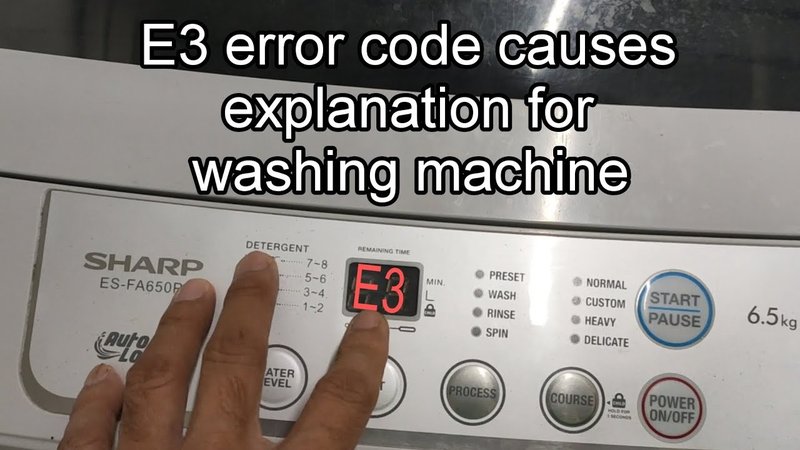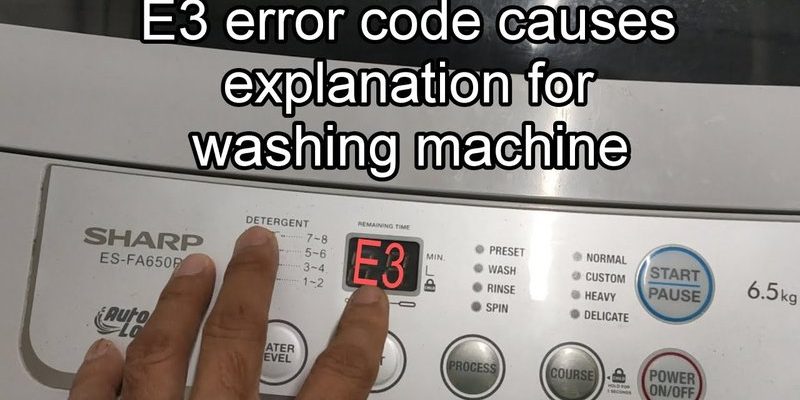
So, what does this E3 error code mean? In simple terms, it’s your washing machine’s way of saying that it’s having trouble doing its job properly. Think of it as a tiny distress signal from your appliance. While it might sound like a serious problem, it’s usually something you can tackle with a bit of patience and some basic troubleshooting. Let’s dive deeper and see what this code is all about and whether you can safely keep using your machine.
Understanding the E3 Error Code
The E3 error code typically indicates a problem with the washing machine’s motor. Imagine if your car’s engine had a hiccup; you’d see a warning light on the dashboard. Similarly, the E3 code is the washing machine’s way of saying, “Hey, something’s not quite right here.” Generally, this suggests that the motor is experiencing overload, which means it’s trying too hard to do its job, much like when you try to lift a suitcase that’s too heavy.
But why does this happen? Often, it’s the result of too many clothes stuffed into the drum. When you overload your washing machine, it’s like asking your car to carry an elephant—it just doesn’t have the power to do it effectively. Overloading can cause the motor to strain, leading to the E3 error code. In some cases, it might also point to a fault in the motor itself or an issue with the wiring or connections inside the machine.
Before you panic, understand that the E3 error code can be relatively straightforward to resolve. Start by switching off the machine and removing some of the laundry if you suspect overloading is the culprit. Then, give it a fresh start and see if the code disappears. If it persists, it might be time to dig a little deeper or call in some expert help.
Is It Safe to Continue Using Your Washer?
Here’s the deal: running your washing machine with an E3 error isn’t the best idea. It’s like driving with your car’s check engine light on. You might be able to get away with it for a short while, but ignoring it could lead to bigger issues. By continuing to use the machine, you risk causing more damage to the motor or other components, turning a simple fix into a costly repair. Nobody wants that!
In some situations, you might be tempted to power through the error to get the laundry done, especially if you’re in a pinch. However, doing so may lead to increased wear and tear on the machine, reducing its lifespan and efficiency. It’s like trying to run a marathon with a sprained ankle—it’s going to hurt you more in the long run.
So, what should you do? First, address the possible causes like overloading or power surges. If the machine still shows the E3 error after removing some clothes or checking the power supply, consider contacting a professional technician. Sometimes, a little expert knowledge goes a long way in preserving the life of your appliances.
Steps to Fix the E3 Error Code
Fixing the E3 error can be as simple as lightening the load. Start by removing some of the clothing from the drum and then reset the machine to see if that clears the error. Let’s think of it like clearing your fridge of some extra weight to stop the door from creaking. Often, spreading out the laundry over more loads will give your machine a much-needed break.
If reducing the load doesn’t work, check the power supply. Sometimes, an electrical issue can trigger the E3 code, so ensure that the plug is properly connected and the outlet is working correctly. It’s not uncommon for a tripped circuit breaker to cause problems, much like when too many devices are plugged into a single power strip.
And if all else fails? Don’t hesitate to bring in a trained appliance repair technician. They’ll have the tools and skills needed to dig deeper into the machine, inspecting parts like the motor and wiring. Think of them as the doctors of the appliance world, ready to diagnose and fix what ails your machine.
Preventing Future Errors
Once you’ve tamed the E3 error beast, consider taking steps to prevent it from coming back. Much like maintaining a healthy diet to avoid future doctor visits, keeping your washing machine in top shape will save headaches down the road. Start by making sure you’re not overloading the machine. Follow the manufacturer’s guidelines about load size, using the amount of detergent suitable for your machine model.
Regular maintenance can also go a long way. Clean out the filter and drum periodically to keep everything running smoothly. It’s akin to brushing your teeth to keep them shiny and strong—simple habits that prevent future problems. Stay aware of any strange noises or behavior, as these can be early warnings of bigger issues.
Lastly, don’t ignore those warning signs. Addressing small problems quickly can prevent them from snowballing into larger ones. So keep an eye on your machine, and treat it well. It’ll thank you by running smoothly for years to come.
In conclusion, while the E3 error code on your GE washing machine is not a death sentence for your appliance, it’s a call to action—one that, if heeded quickly and correctly, can save you from bigger issues down the line. So go on, roll up those sleeves, and get your machine back to its merry, spinning self!
